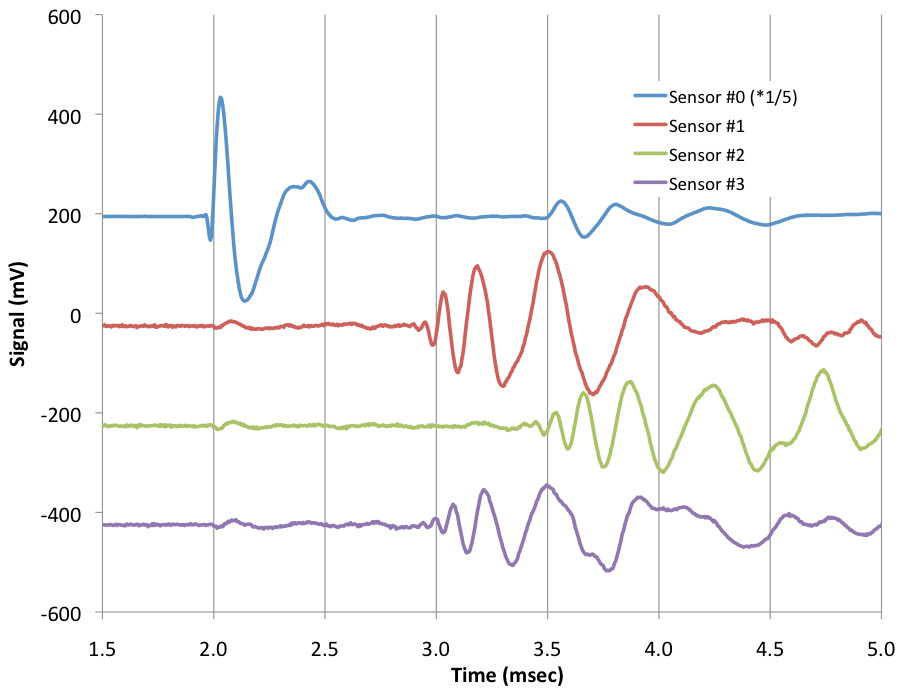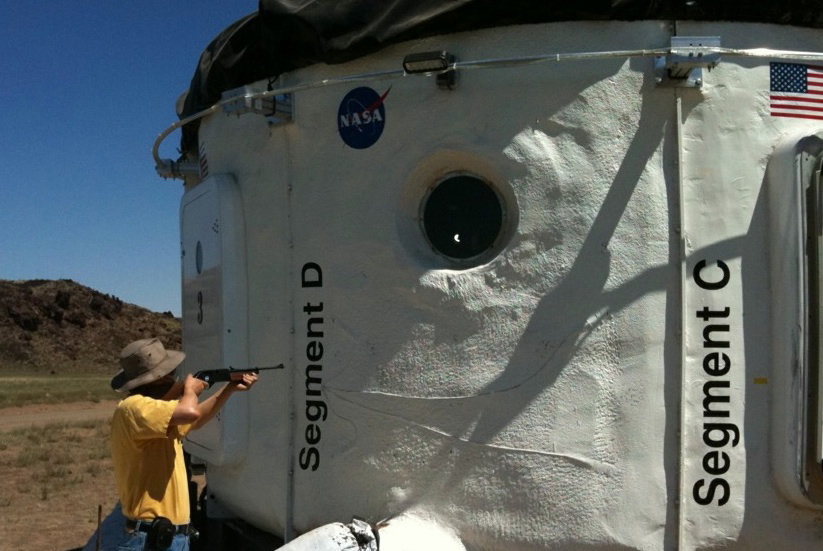
Dr. Robert Corsaro – Bob.Corsaro.ctr@NRL.Navy.mil
Naval Research Laboratory (GSG)
4555 Overlook Ave.
Washington, DC 20375
Dr. Jer-Chyi Liou – jer-chyi.liou-1@NASA.gov
NASA Johnson Space Center
2101 NASA Parkway
Houston, TX 77058
Dr. Frank Giovane – fgiovane@vt.edu
Virginia Polytechnic Institute
Department of Physics
Blacksburg, VA 24060
Popular version of paper 4pEA2
Presented Thursday afternoon, May 26, 2011
161st ASA Meeting, Seattle, Wash.
Astronauts live in a shooting range. Just beyond their living space, tiny projectiles traveling twenty times faster than a speeding bullet are whizzing by. Half of these are man-made orbital debris from spacecraft – typically satellite breakup fragments and paint chips. The other half are tiny meteoroids, smaller than 5 mm, called micrometeoroids or interplanetary dust. Orbital debris larger than 10 centimeters are infrequent, and can be tracked from earth and avoided. For example, the International Space Station (ISS) has performed 12 collision avoidance maneuvers since 1999. Smaller objects, however, cannot be seen from earth and are very prevalent. Tiny micrometeoroids are so common that on an average day the earth is hit by approximately 100 tons of them. These smaller projectiles pose no danger on the ground since most of them burn up in the earth's atmosphere. However spacecraft and space habitation modules are directly exposed. An impact by even a small particle traveling at these hyper-fast speeds (6 miles per sec or faster) can cause significant damage, typically blasting a hole ten to twenty times larger than the size of the particle. To avoid this damage, the living areas and critical systems on spacecraft are protected by shields. However, due to weight limitations, not all surfaces can be properly protected.
These small, fast particles (micrometeoroids and orbital debris) have damaged various systems in space. (Figure 1) For example, after every Space Shuttle flight, typically two windows must be replaced due to particle impact damage. Small particles are known to have severed electrical cables, and are suspected as the cause of other electrical, hydrolytic and fluid transfer system failures, such as a power cable on the ISS that was found to be severed.

Figure 1. Examples of damage caused by a 0.06 mm particle hit on the Space Shuttle window, and a 1 mm size particle on a satellite electrical cable.
As NASA begins designing habitats for astronauts to live in space or on other bodies (moon, mars, asteroids), there is an obvious need for an instrument to alert the crew when and where a damaging impact occurs. To evaluate if any important systems might be damaged, the astronaut needs to know both the approximate size of the impacting particle and the region of the spacecraft affected. If the astronaut decides that a repair may be needed, they must locate and visually inspect the damaged location. Since these holes are small, locating them without an accurate identification of the impact site can be a very lengthy process. For example, in 2004 astronauts on the ISS determined that there was an air leak, and they worked for several days before locating it. Although this leak was not caused by impact damage, this case illustrates the difficulty in locating the site of damage and the value of an instrument that can provide this information.
This paper describes the development of an instrument to meet this need. It was designed and tested by a team from multiple institutions in the US and UK under the leadership of the NASA Orbital Debris Program Office. Its operation is simple. When a particle hits the wall of the habitat it makes a rather loud noise and generates an acoustic wave (sound and vibration) in the wall material. This wave travels within the walls away from the impact point, and can be detected at a considerable distance (tens of meters) by strain sensors placed on the walls. The strain sensors used are postage-stamp size plastic sensors made from a very sensitive piezoelectric polymer. As the acoustic wave passes each sensor, the polymer generates a charge or voltage proportional to the strain. (Figure 2) The location of the impact can then be deduced since we know where the sensors were placed, and can measure the time when the acoustic wave arrives at each sensor. Also, the amplitude of the signals at these locations can be used to estimate the energy released by the collision at the impact location. This gives immediate information to the onboard astronauts that will enable them to access the importance of the event. Should a repair be needed it will direct them to the damage location.

Figure 2. Signals arriving at four sensor locations on the HUD module.
The system was recently tested on the NASA Habitat Demonstration Unit (HDU) during the 2010 Desert Research and Technology Studies (D-RATS) field test conducted last fall. The system was operational for over 40 hours during which it collected background acoustic data during normal crew activities. Periodically an air rifle was used to produce an impact event on the outside of the habitat wall (Figure 3). Although the air rifle can only deliver a small fraction of the energy expected from a hyper-speed particle, it was sufficient to generate reasonable signal levels at the sensor locations. Results from this test were collected and analyzed after the exercise.

Figure 3. Using an air rifle to simulate hyper-speed particle impacts on the NASA HDU during the 2010 D-RATS exercise in northern Arizona.
The finding is that the system correctly identified all 147 projectile impacts. It determined the impact location of each to within 8 cm, which is much higher accuracy than operationally required. Signal levels were also found to vary reproducibly with changes in projectile kinetic energy. It also captured 294 non-impact signals which were later identified by their very short duration as non-acoustic electrical spikes caused by the cycling of the habitat power generator. A simple waveform-duration criterion was then applied to the data set, and all but four of these false signals were eliminated. The four remaining false signals were acoustic and presumably due to noisy crew activities very near the sensors. These false signals had very low amplitudes and if interpreted as impacts they would have been listed as inconsequential.
An improved fully-automated system is now in place in the HDU ready for a real-time evaluation during the 2011 D-RATS campaign scheduled for late September. This system requires no operator involvement. When a suspect event occurs at any time during the exercise, it will automatically log the time and signal waveforms received, calculate the impact location, evaluate the energy associated with the event, and use the waveform shape to calculate the probability that the event is an impact rather than extraneous noise. In additional to storing this information in files, it displays the impact location on the crew monitor with indicators (symbol shape, size and color) that quickly conveys the needed information to the crew.
Other acoustic systems have also been developed for research applications. These measure the flux of micrometeoroids and orbital debris, both to refine our knowledge of the danger they present as well as for scientific investigations into their origin. These other systems will also be briefly discussed.